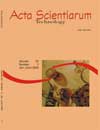<b>Resolution of differential equations with artificial neural networks: high gradients and arbitrary domains problems</b> - DOI: 10.4025/actascitechnol.v27i1.1507
DOI:
https://doi.org/10.4025/actascitechnol.v27i1.1507Keywords:
redes neurais, equações diferenciais, gradientes elevadosAbstract
In this paper, the ability of the multilayer perceptron neural network (MLP) in interpolation was used to analyze two classes of boundary value problems. The first class is formed by differential equations, with solutions which can have high gradients and the second are partial differential equations, defined on arbitrary shaped domain. Also, the methodologies proposed by Lagaris et al. (1998) were enlarged for differential equations subjected to Cauchy and mix boundary conditions type. The results of the artificial neural network method are very precise when comparison to the analytical ones or those of classical numerical methods to solve differential equations. The precision achieved in the results and the ability to handle the method, to solve those boundary value problems, were encouraging to keep the research, particularly on an important direction, concerning convergence and numerical stabilityDownloads
Download data is not yet available.
Downloads
Published
2008-03-27
How to Cite
Silva, L. H. M. e, Neitzel, I., & Lima, E. P. (2008). <b>Resolution of differential equations with artificial neural networks: high gradients and arbitrary domains problems</b> - DOI: 10.4025/actascitechnol.v27i1.1507. Acta Scientiarum. Technology, 27(1), 7–16. https://doi.org/10.4025/actascitechnol.v27i1.1507
Issue
Section
Chemical Engineering
License
DECLARATION OF ORIGINALITY AND COPYRIGHTS
I Declare that current article is original and has not been submitted for publication, in part or in whole, to any other national or international journal.
The copyrights belong exclusively to the authors. Published content is licensed under Creative Commons Attribution 4.0 (CC BY 4.0) guidelines, which allows sharing (copy and distribution of the material in any medium or format) and adaptation (remix, transform, and build upon the material) for any purpose, even commercially, under the terms of attribution.
Read this link for further information on how to use CC BY 4.0 properly.











8.png)




